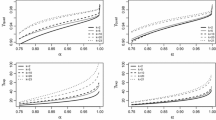Summary
In this paper we derived a system of asset demand functions from an expected utility maximization model, in which the utility function satisfies both the decreasing absolute risk aversion as well as the increasing relative risk aversion criteria. The rates of return are assumed to be distributed as a multivariate log-normal distribution. It is shown that a system of log-linear asset demand functions follows from the exact model as an approximation and performs better than similar types of linear asset demand functions which follow from a negative exponential utility function.
Similar content being viewed by others
References
Aitchison, J. and J. A. C. Brown,The Lognormal Distribution, Cambridge, 1957.
Arrow, K. J.,Aspects of the theory of Risk-Bearing, Helsinki, 1965.
Barret, R. J., M. R. Gray, and J. M. Parkin, ‘The Demand for Financial Assets by the Personal Sector of the U.K. Economy,’ in G. A. Renton, (ed.)Modelling the Economy, London, 1975.
Bhattacharyya, D. K., ‘An Econometric Study of Some Aspects of the Personal Sector Behaviour in the Financial Market.’ Ph. D. thesis, Department of Economics, University of Essex, Colchester, 1975.
Bhatfacharyya, D. K., ‘On the Validity of the Quadratic Utility Approach in Mean-Variance Portfolio Analysis: An Empirical Test,’De Economist, CXXVII (1979a), pp. 422–445.
Bhattacharyya, D. K.,On Measuring the Nearness ofNear-Moneys: An Econometric Experiment with the U.K. Personal Sector Data, paper presented to the European Meeting of the Econometric Society in Athens, 1979b.
Cootner, P. H.,The Random Character of Stock-Market Prices, Cambridge, Massachusetts, 1964.
Dhrymes, P. J.,Econometrics, Harper and Row, 1970.
Feige, E. L. and P. A. V. B. Swamy, ‘A Random Coefficient Model of the Demand for Liquid Assets,’Journal of Money, Credit and Banking, VI, (1974) pp. 241–252.
Gramlich, E. M. and D. T. Hulett, ‘The Demand for and Supply of Savings Deposits,’ in E. M. Gramlich and D. M. Jaffee, (eds),Savings Deposits, Mortgages and Housing, Saxon House Publications, (1972) pp. 13–62.
Lancaster, K.,Consumer Demand: A New Approach, New York, 1971.
Malinvaud, E.,Statistical Methods of Econometrics, Amsterdam, 1970.
Merton, R. C., ‘Optimum Consumption and Portfolio Rules in a Continuous-Time Model,’The Journal of Economic Theory, III (1971) pp. 373–413.
Morishima, M., ‘A Two-Parametric ‘Revealed Preference’ Theory of Portfolio Selection,’ in M. Morishima,et al., Theory of Demand: Real and Monetary, Oxford, 1973.
Parkin, J. M., ‘Discount House Portfolio and Debt Selection,’Review of Economic Studies, XXXVII (1970) pp. 469–497.
Pratt, J., ‘Risk Aversion in the Small and Large,’Econometrica, XXXII (1964) pp. 122–136.
Royama, S. and K. Hamada, ‘Substitutability and Complementarity in the Choice of Risky Assets,’ in D. D. Hester and J. Tobin (eds.)Risk Aversion and Portfolio Choice, Cowles Foundation Monograph, 19, New York, 1967.
Von Neuman, John, and Osker Morgenstern,Theory of Games and Economic Behaviour, Princeton University Press, 1953.
Zarembka, Paul, ‘Functional Form in the Demand for Money,’Journal of American Statistical Association LXIII (1968), pp. 502–511.
Zellner, A., ‘An Efficient Method of Estimating Seemingly Unrelated Regressions and Tests for Aggregation Bias,’Journal of American Statistical Association, LVII (1962), pp. 348–368.
Author information
Authors and Affiliations
Additional information
I am grateful to Professor A. R. Bergstrom and Mr. R. E. Bailey for their comments on an earlier draft. Comments from the referee of this journal helped me to improve my presentation. I am also grateful to Professor R. Bandyopadhyay for his comments. I am solely responsible for any errors.
Rights and permissions
About this article
Cite this article
Bhattacharyya, D.K. An economic rationale for a system of loglinear asset demand functions. De Economist 128, 205–225 (1980). https://doi.org/10.1007/BF01717801
Issue Date:
DOI: https://doi.org/10.1007/BF01717801




